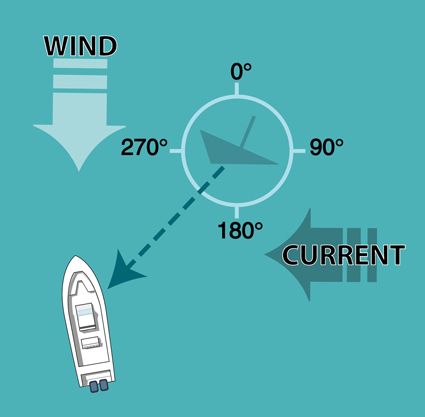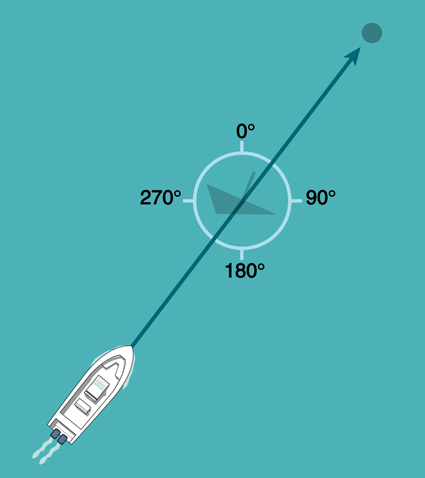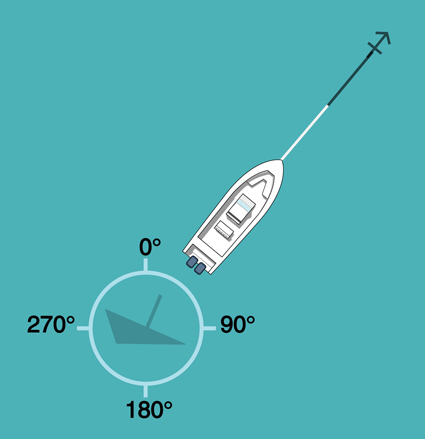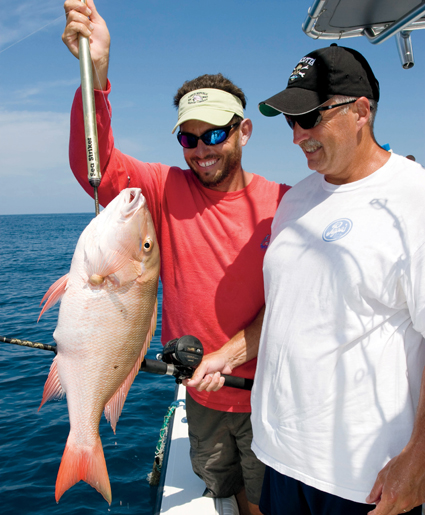September 01, 2008
By Al Herum
Easy wreck techniques for making the most out of a late-summer day on the blue.
We had been probing flat seas far offshore for signs of dolphin on a sweltering mid-August day. This late in the season, fish were proving scarce. Chatter on the VHF confirmed our plight with other boats reporting few sightings and meager catches.
Key West charter captain Pepe Gonzalez decided to throw a changeup and head for green waters closer to shore. Plan B was a few quick drops on deep wrecks. Gonzalez, using the foresight expected of a full-time captain, had prepared for this by loading up on live pinfish that morning.
As we eased off plane passing the 40-fathom line, Gonzalez began to circle slowly and look for one of five nearby wrecks in the area. The sites he was interested in ranged in depths from 80 to 220 feet—a range that's productive at this time of the year in many parts of Florida.
Our last drop of the day put the fillets on the dinner table. Frank Blee, a striped bass aficionado who hails from Absecon, New Jersey, dropped a hand-size live pinfish to the bottom. Within a few minutes, the bait got nervous and began telegraphing its desperate message back through the line. Soon Blee's rod bowed nearly to the water with line peeling off the reel. The fish fought in strong bursts, but with steady pumping and winding Blee soon had a plump mutton snapper sliding toward the gaff. One clean swing by Gonzalez and we had our colorful, tasty prize aboard.
The wrecks Gonzalez put us on—with names like the Pineapple wreck, the Curb and the Unknown wreck—all had big fish which bit our baits. Problem was, landing some of these bruisers proved more difficult than getting the bite. Within an hour of making our first drop we managed to land several amberjacks and our prize mutton snapper.
Gonzalez mainly uses his conglomeration of structure close to home to pick up a fish or two or three when pelagic species such as dolphin and sailfish are playing hard to get. On other occasions he anchors down on one of the wrecks and fishes the bottom with a couple rods while freelining bait for yellowtail snapper. Gonzalez emphasized that, “These wrecks produce a wide variety of bottom-dwellers year-round. Expect shots at all kinds of snapper, including yellowtail, mutton, silk, mangrove, lane and even genuine reds. You'll also find grouper, African pompano, amberjack, occasional cobia, and at certain times of the year pelagics like kingfish, wahoo and sailfish can be caught.”
Key West has the market cornered on wreck-fishing variety, poised as it is at the intersection of the Gulf of Mexico and Atlantic Ocean. Nevertheless, the spectrum of fish Gonzalez described paints a fairly accurate portrait of many wrecks distributed along both Florida coasts. Freshmen anglers will note many productive spots are listed on retail fishing charts as well as Web sites such as floridasportsman.com and myfwc.com. Techniques honed by Key West fishermen have similarly broad applications.
When drifting deep wrecks and fishing the bottom, Gonzalez likes to see the current running but not too strong.
“A light current is ideal; it lets you feel the bottom and stay down without using a huge lead. A lighter lead makes it easier to detect a bite.”
Current in this case may take the form of incipient Gulf Stream flows, which generally flow west-to-east along the Lower Florida Keys. Wind, tides and sheer happenstance may cause local currents to change direction or velocity.
A slow drift over and around submerged structure allows your baits to continually drift over new bottom and in front of new fish. Sometimes a bait moving with the current will trigger even a lethargic predator to strike, presumably because the fish doesn't want to miss an easy meal.
Typical of light-tackle guides in this region, Gonzalez had rows of rods aboard his 27-foot center console. He favors tackle which anglers can fish all day without suffering from physical exhaustion and without using any type of harness.
For bottom fishing deep wrecks, Gonzalez chooses 7-foot medium-duty graphite rods with sensitive tips coupled to a conventional reel spooled with either 20- or 25-pound-test monofilament line. His personal choice for a reel is a Shimano TLD15; this reel retrieves about 21/2 feet of line per turn of the handle, doesn't have a crossbar on top to jam line when the spool is full, and has a smooth lever drag with adequate power for the 20-pound line class. Plus, it only weighs a tad over a pound. This is a popular-size reel, and other manufacturers offer suitable equivalents.
To give his anglers more of an advantage with the light tackle, Gonzalez likes to drift the outside edges of the wrecks and continue the drift well past the actual structure, as long as he is still marking fish on his sounder. We marked fish well downcurrent of almost every wreck we drifted and hooked our fat mutton far off the structure.
The main line of every rod on Gonzalez's boat gets doubled with a Bimini twist before anything else gets tied to it; this preserves the full breaking strength of the line, crucial when you hook something burly on a reef. His typical bottom rig begins with a 3-foot double line with a Bimini twist. Onto the doubled section he slides an egg sinker big enough to hold bottom (in our case 4 to 6 ounces worked well) and then ties on a barrel swivel with a breaking strength rated several times higher than the main line. He then attaches five or six feet of 60-pound-test monofilament leader and a sharp 5/0 hook. It's a simple rig that works well for bottom critters and doesn't get tangled easily.
Since we were fishing in the summer, we used live pinfish for bait that we had pulled out of a trap set bayside earlier in the day. At other times of the year Gonzalez favors different bottom baits. In the winter he likes to use thread herring, while in the fall months of October and November he catches and uses large pilchards. His favorite bait, though, is a live or fresh dead ballyhoo caught on the spot. All of these baits are fished on the same rigs we used.

In neutral, note bearing back to grouper spot. |

Run up and begin drift at reciprocal bearing. |

Anchor set in same way. |
Drift Check
Range and Bearing: These are the two figures you'll want to stick in your head when drifting a deepwater wreck. Once you have them, you can make repeated passes regardless of wind and current.
When you mark the desired spot on your sonar and confirm latitude and longitude on your GPS, put the engine in neutral and watch your GPS to determine the drift. While you're at it, drop a jig (I like about one ounce per 50 feet, for starters). Allow a few minutes for the net effects of wind and current to manifest themselves. You'll now have a compass bearing back to the wreck, and some idea of the range (distance), which reflects the rate of your drift. For the sake of illustration, let's say 45 degrees at .04 nautical miles, and it took you three minutes to get there. Now calculate the reciprocal of that bearing. The “200/20” rule is pretty easy to remember: Add 200 degrees, and subtract 20; from 45, you get 225 degrees (subtract 200 degrees and add 20, if original bearing was greater than 180 degrees—the final figure, obviously, must be between 0 and 360).
Now, in this case, it's as easy as running back up-drift of the reef site until your bearing indicates 225 degrees at whatever distance is appropriate to reach bottom. You may have determined that figure when you dropped that first jig (you did, didn't you?).
The same procedure will tune you in to where you might place your anchor, if you decide that's what you want to do. In this case, it's always better to drop the anchor farther up-drift than you might think necessary; you can always let out more line to “slide” back to the desired position. Rarely is it desirable to have your boat anchored directly atop or, worse, down-drift of the wreck. When in doubt, careful attention to the sonar screen—not to mention baits—should settle any disputes.
Some final thoughts on wreck fishing courtesy:
• Do not attempt to anchor on wrecks where boats are already drifting. Instead, fall in line with the pack, always starting up-drift so that you don't interrupt another boat's course.
• If the majority of boats are anchored on a spot, never anchor directly down-drift of someone; always try to set the anchor so your transoms are roughly equal, and so your vessel is no closer to the next one than others already on the spot. Fishermen may grumble about other boats, but they get downright furious about anglers disturbing a chumslick.
• Consider the size and source of the structure. A large, publicly funded shipwreck or rubble pile may easily accommodate a half-dozen vessels, whereas a very small shrimpboat may be an exercise in frustration.
• If you see a boat anchored on a spot that is not on your chart, do not try to fish there. When in doubt, remember the Golden Rule: Do unto others...

Key West captain Pepe Gonzalez sticks a mutton snapper for angler Frank Blee. |
Stop and Drop, Keys-Style
Islamorada offshore captain Carlos Jimenez gave us the lowdown on how he fishes the deep wrecks in the Middle and Upper keys. One of his favorite tactics when sending bait down on a deep wreck is to do the stop-and-drop. This technique gives you a shot at cruising pelagics, even the toothy ones, and your favorite bottom denizens. It can be used on deep wrecks anywhere.
First, Jimenez rigs up a 20-pound-class conventional (revolving spool) outfit by doubling about three feet of the main line with a Bimini twist or spider hitch. Then he cuts a 30-foot section of 30- or 40-pound mono for the leader. He connects the leader by folding over a 3-inch section, and then ties an Albright special knot around the leader with the doubled main line. Here's the important part: He cuts the tag end off the leader but leaves the small loop created by the main line. This is where you'll attach a lead later.
The terminal end of the leader is finished off with two feet of No. 3 or 4 singlestrand wire connected to a single number 3/0 livebait hook. Use either an Albright special or a small barrel swivel to connect the mono to the wire. A stinger is added using No. 4 wire haywire-twisted to a No. 2, 4X strong treble hook. Vary the length of the stinger wire depending on the size of the bait you're using. Jimenez favors cigar minnows.
To deploy the rig, cast the bait behind the boat so that the loop is out of the rodtip. Now you'll need to attach a lead. Take an egg sinker, big enough so your rig will make it to the bottom, tie on about a foot of light mono, and then tie on a snap swivel. You should attach the snap to the loop you left at the leader attachment knot. When you bring the rig back up from the bottom you simply unsnap the weight and continue to wind the leader into the rod guides to get the fish within gaffing range.
Here's how the stop and drop works: Start your first drift well upcurrent so that you'll have time to drop your bait at a rate of no more than about 100 feet per minute. Slow is good. It keeps your bait in the zone and keeps the leader from tangling on the way down. Plan your stops for every 50 feet and time them so that your bait makes it to the bottom just as it reaches the wreck. The goal is to fish for pelagics holding up in the water column before you reach the fish holding on the wreck or down current. You can retrieve the rig the same way, stopping at intervals on the way up after you're well past all the structure.
According to Jimenez, “You have to be close enough to get a bite but not so close that you hang the wreck. If you're hanging up, start your drift slightly off to one side. If you're not getting bites move in closer to the structure. Try to achieve a balance of getting bites without getting hung up. Once you find it stay with it.”

It's an African pompano for FS Keys Field Editor Al Herum. |
About Florida Keys Wrecks
Old shrimp boats, long-ago retired charterboats, large steel-hulled freighters and even sunken cars are strewn along the island chain from Key West to Ocean Reef. Many of the wrecks are named for the nearby reef light or buoy that sits inshore of their final position. Others are simply named for the depth where they lay. Check Florida Sportsman fishing charts to get exact locations of some of these fishing havens. Don't let the fact that many of these numbers are well-publicized keep you from fishing them. They all hold huge numbers of prized fish.
FS
